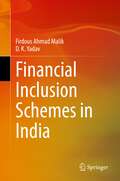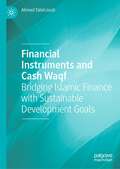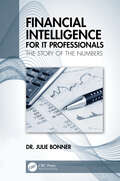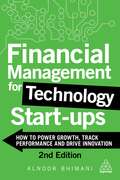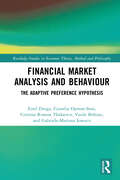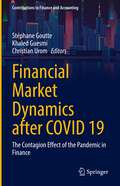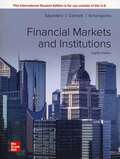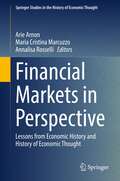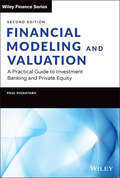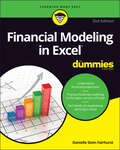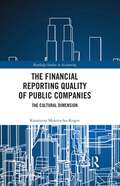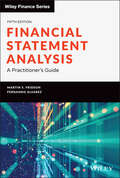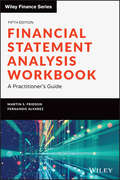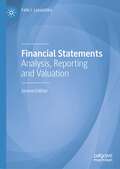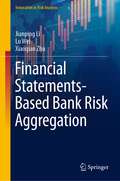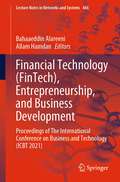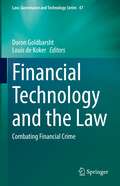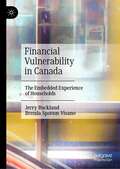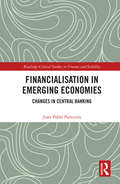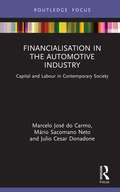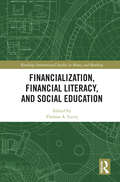- Table View
- List View
Financial Inclusion Schemes in India
by Firdous Ahmad Malik D. K. YadavThe exclusion of the destitute population from the formal financial system is a long-standing problem in India. This book examines the performance of financial inclusion policies in India to understand their impact on two urban vulnerable groups, Slum Dwellers and Beggars. This study includes analysis at the national level, the variables of the financial inclusion index like Penetration, Availability, and Usage from 2006 to 2020 from the world bank data set. Similarly, the authors examine five policies on financial inclusion by conducting a primary level survey on two urban capital cities of Lucknow and Kolkata, using a well-structured questionnaire for data collection. The authors uses two sampling techniques: simple random in the case of beggars, and stratified random in the case of slum dwellers.This book highlights the difference between financial access and non-access of household respondents in capturing the impacts of financial inclusion schemes on their socio-economic condition and financial behavior. The findings indicate that access to these schemes is extremely limited for the underprivileged population, such as beggars and slum dwellers. The analysis has shown that claims made by the government are not based on real-life occurrences. This book demonstrates that these programs have a negligible effect on life-deprived people.This book will be of interest to academia, policymakers, and society at large.
Financial Instruments and Cash Waqf: Bridging Islamic Finance with Sustainable Development Goals
by Ahmed Tahiri-JoutiThe book, organized in three parts, offers a guide to constructing financial instruments based on cash waqf in alignment with the Sustainable Development Goals. The first part discusses the alignment between the Shari'ah economic objectives and the SDGs, the Islamic social finance concept, its instruments and institutions and the intersection between Islamic finance and Islamic social finance. The second part presents a product structure that is based on cash waqf and is targeting the SDGs specifically. Some of these product structures involve zakat collection. The third part of the book presents the methodology to gather all these product structures in a national cash waqf ecosystem that is targeting SDGs. The aim of this ecosystem is to increase the impact of the various initiatives and instruments. In addition to this, the third part of the book presents the concept of Waqf offshore centers and the methodology to conceive and implement them. The aim of these Waqf offshore centers is to connect national cash waqf ecosystems and individuals with investment opportunities bringing more impact. This book will be of interest to academics, researchers, and practitioners of not only Islamic finance but sustainable finance.
Financial Intelligence for IT Professionals: The Story of the Numbers
by Julie BonnerThere are many books written for the accounting and finance community. However, there are very few books written to help the non-financial career professionals who still need to understand the conceptual fundamentals of accounting and finance. In 20 years of teaching this material to non-financial professionals, Dr. Bonner has perfected a teaching approach that works to help the non-financial professional engage with the material to use financial information in leveraging their career without becoming overloaded with information that is not helpful to them. Learning this material takes repetition, application, and building the thinking processes necessary for effectiveness. Many think the challenge with finance is the math, but as this book will demonstrate, it is a conceptual problem. If you understand the conceptual framework, you will understand the math. Dr. Julie Bonner is currently a tenured professor at Central Washington University in the information technology and administrative management department. Her career has spanned business and education for over 30 years. Initially, she received a Bachelor of Science degree in accounting, whereafter she earned an MBA and then a doctorate in organizational leadership.
Financial Management for Technology Start-Ups: How to Power Growth, Track Performance and Drive Innovation
by Alnoor BhimaniMore than a third of start-ups fail due to founders having a poor understanding of financial management. Become financially savvy with this easy to understand guide and learn how to effectively grow your business, communicate with investors and progress to the next level.Start-ups face many challenges but managing the finances does not need to be one. Financial Management for Technology Start-Ups offers a complete financial toolkit on how to use this area of your business to your advantage. This book contains invaluable tools and insights designed specifically for tech start-ups, with a concentrated focus on what is important in financial terms for technology-based and innovation focused entrepreneurial businesses.The fully updated second edition offers greater analysis of financial statements directly from real-world start-ups, charts the success of businesses that went from start-up to scale-up with all new case studies and covers new digital technologies, emerging opportunities in the ecosystem, developing markets and much more. For entrepreneurs and tech innovators, this is a must-have book to help take your idea from concept to company with clear and effective financial insights.
Financial Market Analysis and Behaviour: The Adaptive Preference Hypothesis (Routledge Studies in Economic Theory, Method and Philosophy)
by Emil Dinga Camelia Oprean-Stan Cristina-Roxana Tănăsescu Vasile Brătian Gabriela-Mariana IonescuThis book addresses the functioning of financial markets, in particular the financial market model, and modelling. More specifically, the book provides a model of adaptive preference in the financial market, rather than the model of the adaptive financial market, which is mostly based on Popper's objective propensity for the singular, i.e., unrepeatable, event. As a result, the concept of preference, following Simon's theory of satisficing, is developed in a logical way with the goal of supplying a foundation for a robust theory of adaptive preference in financial market behavior. The book offers new insights into financial market logic, and psychology: 1) advocating for the priority of behavior over information - in opposition to traditional financial market theories; 2) constructing the processes of (co)evolution adaptive preference-financial market using the concept of fetal reaction norms - between financial market and adaptive preference; 3) presenting a new typology of information in the financial market, aimed at proving point (1) above, as well as edifying an explicative mechanism of the evolutionary nature and behavior of the (real) financial market; 4) presenting sufficient, and necessary, principles or assumptions for developing a theory of adaptive preference in the financial market; and 5) proposing a new interpretation of the pair genotype-phenotype in the financial market model. The book's distinguishing feature is its research method, which is mainly logically rather than historically or empirically based. As a result, the book is targeted at generating debate about the best and most scientifically beneficial method of approaching, analyzing, and modelling financial markets.
Financial Market Dynamics after COVID 19: The Contagion Effect of the Pandemic in Finance (Contributions to Finance and Accounting)
by Stéphane Goutte Khaled Guesmi Christian UromThis book analyses the impact of the COVID-19 pandemic in different areas of Finance emphasizing the contagion effect in capital markets. The volume presents evidence-based case studies from the global financial crisis that followed after the onset of the pandemic in March 2020.
Financial Markets And Institutions
by Anthony Saunders Marcia Millon CornettFinancial Markets and Institutions is aimed at the first course in financial markets and institutions at both the undergraduate and MBA levels. While topics covered in this book are found in more advanced textbooks on financial markets and institutions, the explanations and illustrations are aimed at those with little or no practical or academic experience beyond the introductory-level finance courses. In most chapters, the main relationships are presented by figures, graphs, and simple examples. The more complicated details and technical problems related to in-chapter discussion are provided in appendixes to the chapters. Since the author team's focus is on return and risk and the sources of that return and risk in domestic and foreign financial markets and institutions, this text relates ways in which a modern financial manager, saver, and investor can expand return with a managed level of risk to achieve the best, or most favorable, return–risk outcome.
Financial Markets in Perspective: Lessons from Economic History and History of Economic Thought (Springer Studies in the History of Economic Thought)
by Arie Arnon Maria Cristina Marcuzzo Annalisa RosselliThis book examines financial markets from a historical perspective. Bringing together contributions from leading historians of economic thought, economists and economic historians, it offers an integrated approach and reflects on the workings of financial markets, their impact on and relation with the rest of the economy and how their role was and is understood by economics. The contributions cover topics such as classical and modern economic thinking on financial markets and institutions, as well as financial models and innovations, and also present case studies on financial history and on policy issues. The historical perspective leads to a representation of markets not as abstract and timeless mechanisms but as institutions populated by a diversity of agents, subject to rules and customs, and influenced by scientific developments and economic theories.
Financial Modeling and Valuation: A Practical Guide to Investment Banking and Private Equity (Wiley Finance)
by Paul PignataroThe fully revised new edition of the best-selling guide to using financial models to determine if a stock is over or undervalued Written by the founder and CEO of the world-renowned New York School of Finance, Financial Modeling and Valuation provides clear and systematic guidance on accurately evaluating the soundness of a stock investment. This invaluable handbook equips investors with the tools necessary for understanding the underlying fundamentals of a rational investment and for making smarter investment decisions in any market environment. Built around an in-depth case study of global retail leader Amazon, this fully updated Second Edition shows you how to analyze the financial standing of a company using the methods of Wall Street professionals. Step-by-step, you will learn to build the core three statements—income statement, cash flow statement, and balance sheet—as well as the three major supporting schedules required for complete company valuation and analysis. All line items are explained in clear language and include real-world tips and techniques for using them as tools for valuing and managing a business. This must-have guide: Features new and in-depth case studies based on Amazon that simulate real-world modelling and valuation Explains valuation techniques such as illustrative comparable company analysis, precedent transactions analysis, and discounted cash flow analysis Covers all essential applications of a model, including pricing a stock, raising debt, and raising equity Includes an introductory section describing the recent and dramatic shift of the entire retail industry Provides end-of-chapter questions, downloadable practice models, additional case studies, and common interview questions via a companion website Financial Modeling and Valuation: A Practical Guide to Investment Banking and Private Equity, Second Edition is essential reading for finance professionals, venture capitalists, individual investors, and students in investment banking and related degree programs in finance.
Financial Modeling in Excel For Dummies
by Danielle Stein FairhurstTurn your financial data into insightful decisions with this straightforward guide to financial modeling with Excel Interested in learning how to build practical financial models and forecasts but concerned that you don’t have the math skills or technical know-how? We’ve got you covered! Financial decision-making has never been easier than with Financial Modeling in Excel For Dummies. Whether you work at a mom-and-pop retail store or a multinational corporation, you can learn how to build budgets, project your profits into the future, model capital depreciation, value your assets, and more. You’ll learn by doing as this book walks you through practical, hands-on exercises to help you build powerful models using just a regular version of Excel, which you’ve probably already got on your PC. You’ll also: Master the tools and strategies that help you draw insights from numbers and data you’ve already got Build a successful financial model from scratch, or work with and modify an existing one to your liking Create new and unexpected business strategies with the ideas and conclusions you generate with scenario analysis Don’t go buying specialized software or hiring that expensive consultant when you don’t need either one. If you’ve got this book and a working version of Microsoft Excel, you’ve got all the tools you need to build sophisticated and useful financial models in no time!
The Financial Reporting Quality of Public Companies: The Cultural Dimension (Routledge Studies in Accounting)
by Katarzyna Mokrzycka-KogutThe factors determining the formation of accounting principles in different countries have long been studied. Cultural conditions have been identified as one of the reasons for national variations. This issue is particularly important when there is an effort to harmonise and standardise accounting principles, in order to create a uniform system, which may be adopted globally. This book explores the impact of cultural conditions on the financial reporting quality of public companies preparing financial statements according to International Accounting Standards (IAS) and International Financial Reporting Standards (IFRS). It discusses the main trends in the theory of capital and earnings in the economy. The book focuses on the relationship between the cultural dimensions under analysis, such as power distance, individualism/collectivism, masculinity/feminity, strong uncertainty/weak uncertainty, short/ long time orientation and indulgence/restraint, and the properties of the financial results; persistence, predictive value, accrual adjustments and earnings smoothing. It identifies the determinants - cultural conditions that have a statistically material impact, either positive or negative, on various attributes of the quality of the financial results of public companies. The book contains an up-to-date, in-depth description of the financial statements of public companies, across of variety of countries and sectors. The publication is addressed to researchers and students concerned with the functioning of capital markets and financial reporting quality and those who would like to expand their knowledge in the field of behavioural finance, as well as investors in capital markets.
The Financial Reporting Quality of Public Companies: The Cultural Dimension (Routledge Studies in Accounting)
by Katarzyna Mokrzycka-KogutThe factors determining the formation of accounting principles in different countries have long been studied. Cultural conditions have been identified as one of the reasons for national variations. This issue is particularly important when there is an effort to harmonise and standardise accounting principles, in order to create a uniform system, which may be adopted globally. This book explores the impact of cultural conditions on the financial reporting quality of public companies preparing financial statements according to International Accounting Standards (IAS) and International Financial Reporting Standards (IFRS). It discusses the main trends in the theory of capital and earnings in the economy. The book focuses on the relationship between the cultural dimensions under analysis, such as power distance, individualism/collectivism, masculinity/feminity, strong uncertainty/weak uncertainty, short/ long time orientation and indulgence/restraint, and the properties of the financial results; persistence, predictive value, accrual adjustments and earnings smoothing. It identifies the determinants - cultural conditions that have a statistically material impact, either positive or negative, on various attributes of the quality of the financial results of public companies. The book contains an up-to-date, in-depth description of the financial statements of public companies, across of variety of countries and sectors. The publication is addressed to researchers and students concerned with the functioning of capital markets and financial reporting quality and those who would like to expand their knowledge in the field of behavioural finance, as well as investors in capital markets.
Financial Statement Analysis: A Practitioner's Guide (Wiley Finance #597)
by Martin S. Fridson Fernando AlvarezThe updated, real-world guide to interpreting and unpacking GAAP and non-GAAP financial statements In Financial Statement Analysis, 5th Edition, leading investment authority Martin Fridson returns with Fernando Alvarez to provide the analytical framework you need to scrutinize financial statements, whether you're evaluating a company's stock price or determining valuations for a merger or acquisition. Rather than taking financial statements at face value, you'll learn practical and straightforward analytical techniques for uncovering the reality behind the numbers. This fully revised and up-to-date 5th Edition offers fresh information that will help you to evaluate financial statements in today's volatile markets and uncertain economy. The declining connection between GAAP earnings and stock prices has introduced a need to discriminate between instructive and misleading non-GAAP alternatives. This book integrates the alternatives and provides guidance on understanding the extent to which non-GAAP reports, particularly from US companies, may be biased. Understanding financial statements is an essential skill for business professionals and investors. Most books on the subject proceed from the questionable premise that companies' objective is to present a true picture of their financial condition. A safer assumption is that they seek to minimize the cost of raising capital by portraying themselves in the most favorable light possible. Financial Statement Analysis teaches readers the tricks that companies use to mislead, so readers can more clearly interpret statements. Learn how to read and understand financial statements prepared according to GAAP and non-GAAP standards Compare CFROI, EVA, Valens, and other non-GAAP methodologies to determine how accurate companies' reports are Improve your business decision making, stock valuations, or merger and acquisition strategy Develop the essential skill of quickly and accurately gathering and assessing information from financial statements of all types Professional analysts, investors, and students will gain valuable knowledge from this updated edition of the popular guide. Filled with real-life examples and expert advice, Financial Statement Analysis, 5th Edition, will help you interpret and unpack financial statements.
Financial Statement Analysis Workbook: A Practitioner's Guide (Wiley Finance #79)
by Martin S. Fridson Fernando AlvarezThe helpful workbook to help practice assessing financial statements Financial statement analysis is essential as part of any well-organized financial portfolio. As a companion piece, Financial Statement Analysis Workbook: A Practitioner's Guide allows readers the opportunity to test and hone the skills put forward in Martin Fridson and Fernando Alvarez's Financial Statement Analysis, a resource devoted to providing the analytical framework necessary to make sense of the sometimes misleading numbers put forth by companies. Scrutinizing financial statements allows one to, for example, evaluate a company&’s stock price or determine merger or acquisition valuations. The Financial Statement Analysis Workbook, then, provides a pathway to become familiar with these methodologies in order to be prepared to use them in real-world scenarios. With the skills provided within, you can begin to undertake goal-oriented preparation for the practical challenges of contemporary business, and feel confident in your financial decision-making. This is aided by: Question-and-answer sections within this Workbook correspond to each chapter of Financial Statement Analysis Financial statement and computational exercises designed to require analysis and synthesis of concepts covered in the core text A full list of answers in the second half of the book that help explain pitfalls within the questions An essential tool for professional analysts, investors, and students, Financial Statement Analysis Workbook offers the perfect opportunity to help turn theory into reality.
Financial Statements: Analysis, Reporting and Valuation
by Felix I. LessamboThrough a mixture of concepts and examples, the second edition of this book demystifies the variety of elements of financial accounting and uncovers the need-to-know information for certification in this field. This book covers the two aspects of financial statement analysis, namely quantitative and non-quantitative analysis. Unique to the second edition, the book will also cover Non-GAA- metrics and valuation accounting. Concluding with helpful and updated case studies, the book will appeal to students and academics of financial accounting.
Financial Statements-Based Bank Risk Aggregation (Innovation in Risk Analysis)
by Jianping Li Lu Wei Xiaoqian ZhuThis book proposes a bank risk aggregation framework based on financial statements. Specifically, bank risk aggregation is of great importance to maintain stable operation of banking industry and prevent financial crisis. A major obstacle to bank risk management is the problem of data shortage, which makes many quantitative risk aggregation approaches typically fail. Recently, to overcome the problem of inaccurate total risk results caused by the shortage of risk data, some researchers have proposed a series of financial statements-based bank risk aggregation approaches. However, the existing studies have drawbacks of low frequency and time lag of financial statements data and usually ignore off-balance sheet business risk in bank risk aggregation. Thus, by reviewing the research progress in bank risk aggregation based on financial statements and improving the drawbacks of existing methods, this book proposes a bank risk aggregation framework based on financial statements. It makes full use of information recorded in financial statements, including income statement, on- and off-balance sheet assets, and textual risk disclosures, which solves the problem of data shortage in bank risk aggregation to some extent and improves the reliability and rationality of bank risk aggregation results. This book not only improves the theoretical studies of bank risk aggregation, but also provides an important support for the capital allocation of the banking industry in practice. Thus, this book has theoretical and practical importance for bank managers and researchers of bank risk management.
Financial Technology: Proceedings of The International Conference on Business and Technology (ICBT 2021) (Lecture Notes in Networks and Systems #486)
by Allam Hamdan Bahaaeddin AlareeniThis book constitutes the refereed proceedings of the International Conference on Business and Technology (ICBT2021) organized by EuroMid Academy of Business & Technology (EMABT), held in Istanbul, between 06–07 November 2021. In response to the call for papers for ICBT2021, 485 papers were submitted for presentation and inclusion in the proceedings of the conference. After a careful blind refereeing process, 292 papers were selected for inclusion in the conference proceedings from forty countries. Each of these chapters was evaluated through an editorial board, and each chapter was passed through a double-blind peer-review process.The book highlights a range of topics in the fields of technology, entrepreneurship, business administration, accounting, and economics that can contribute to business development in countries, such as learning machines, artificial intelligence, big data, deep learning, game-based learning, management information system, accounting information system, knowledge management, entrepreneurship, and social enterprise, corporate social responsibility and sustainability, business policy and strategic management, international management and organizations, organizational behavior and HRM, operations management and logistics research, controversial issues in management and organizations, turnaround, corporate entrepreneurship, innovation, legal issues, business ethics, and firm governance, managerial accounting and firm financial affairs, non-traditional research, and creative methodologies.These proceedings are reflecting quality research contributing theoretical and practical implications, for those who are wise to apply the technology within any business sector. It is our hope that the contribution of this book proceedings will be of the academic level which even decision-makers in the various economic and executive-level will get to appreciate.
Financial Technology and the Law: Combating Financial Crime (Law, Governance and Technology Series #47)
by Doron Goldbarsht Louis De KokerBlockchains and cryptocurrencies, open banking, virtual assets, and artificial intelligence have become the buzzword of this decade. This book focuses on these ‘disruptive’ financial technologies that provide alternatives to the traditional financial services typically offered by regulated financial institutions. Financial technologies are characterized by the innovative ways in which they initiate, support or extend traditional financial services or offer alternative financial pathways and products. However, these financial technologies also pose money laundering and terrorist and proliferation financing as well as cyber security risks that require mitigation. This edited volume addresses a range of regulatory and enforcement challenges related to financial technology and financial crime. The book responds to the United Nations’ Sustainable Development Goals, in particular in relation to economic development, employment, national security, law enforcement and social well-being. Fostering responsible financial innovation promotes long-term economic growth, inclusion, and improved living standards. This book explores how to promote financial innovation while mitigating risks in a way that ensures financial prosperity and social inclusion.
Financial Vulnerability in Canada: The Embedded Experience of Households
by Jerry Buckland Brenda Spotton VisanoThis book examines financial vulnerability: a state in which a person or household cannot absorb any substantial spending or negative income shock without substantial financial and ultimately broader harm such as job loss, emotional harm, or mental illness. The focus of the book is on the experiences of low- income and modest income Canadian families – families which, by virtue of being in the lower income brackets, are particularly at risk of experiencing financial hardship. Looking at vulnerability from a conceptual and empirical lens, this book offers a framework to better understand the complex and interdependent ways in which financial vulnerability emerge and can be addressed. By locating its analysis of individual and household financial management in wider community, cultural, and economic contexts, this book seeks to offer holistic policy recommendations to reduce financial vulnerability, with implications that go beyond Canada and to other developed countries.
Financial Wellness and How to Find It
by Melanie Eusebe'Fascinating' Stylist magazine'A powerful reminder that we cannot discuss 'wellness' without also talking about the elephant in the room: money. This book isn't just about getting reconnected with a helpful app or spreadsheet but something much more important than that: it will inspire you to reconnect with yourself.' Emma GannonFinancial Wellness and How to Find It takes finance out of the business pages and into our personal lives. It tells us that the way we think about money has a lot to do with the way we think about ourselves, and the stories we believe about what we deserve.When you feel bad about money, it's hard to feel good about life. We focus on health and wellness as essential for happiness, but so often we choose to bury our heads in the sand when it comes to taking positive action over our finances. Financial wellness doesn't mean being rich, having a portfolio of stocks and shares, or being #debtfree. It's about understanding your emotions around money, knowing who you can turn to for support and being aware of your subconscious beliefs about self-worth.Melanie Eusebe, founder of Money Moves, shares the tools and resources you need to reset your relationship with money, and take charge of your financial happiness, whatever your situation, and regardless of the economy.Financial Wellness and How to Find It is empowering and essential reading for anyone who ever earned a paycheque (and spent it).
Financial Wellness and How to Find It
by Melanie Eusebe'Fascinating' Stylist magazine'A powerful reminder that we cannot discuss 'wellness' without also talking about the elephant in the room: money. This book isn't just about getting reconnected with a helpful app or spreadsheet but something much more important than that: it will inspire you to reconnect with yourself.' Emma GannonFinancial Wellness and How to Find It takes finance out of the business pages and into our personal lives. It tells us that the way we think about money has a lot to do with the way we think about ourselves, and the stories we believe about what we deserve.When you feel bad about money, it's hard to feel good about life. We focus on health and wellness as essential for happiness, but so often we choose to bury our heads in the sand when it comes to taking positive action over our finances. Financial wellness doesn't mean being rich, having a portfolio of stocks and shares, or being #debtfree. It's about understanding your emotions around money, knowing who you can turn to for support and being aware of your subconscious beliefs about self-worth.Melanie Eusebe, founder of Money Moves, shares the tools and resources you need to reset your relationship with money, and take charge of your financial happiness, whatever your situation, and regardless of the economy.Financial Wellness and How to Find It is empowering and essential reading for anyone who ever earned a paycheque (and spent it).
Financialisation in Emerging Economies: Changes in Central Banking (Routledge Critical Studies in Finance and Stability)
by Juan Pablo PainceiraSince the beginning of the 2000s, emerging market economies, or middle-income countries, have embarked on major changes in their domestic financial systems. These changes – in which central banks have been key players – are shaped by the process of financialisation, which can generally be characterised by the dominance of financial considerations in the conduct of major agents (banks, non-financial corporations and households). As a consequence of the emerging markets crisis at the end of the 1990s, a new phenomenon in global financial markets emerged: a massive accumulation of foreign reserves in emerging economies. This has had important consequences for the global economy in which developed economies are the major beneficiaries. Based on Marxist political economy, this book studies the trends towards financialisation in emerging economies, focusing on the effects of the reserve accumulation in their international and domestic spheres. It argues that reserve accumulation has been the very catalyst of financialisation, being related to the subordinated position of emerging economies in the international monetary system. The chapters explore how these trends were exacerbated by the 2008 global financial crisis as well as the extraordinary monetary measures undertaken by the major central banks to deal with the effects of this. Foreign investors invested an enormous amount into emerging economies between 2010 and 2012 and emerging-market financial assets have doubled since 2008. To conclude, the book discusses how the US monetary policy normalisation has added more complexity to these trends since 2013 by putting pressure on emerging markets related to the level of global liquidity. This book provides essential reading for students and scholars of finance, economics and political economy who are interested in the unfolding of the subordinated financial integration of emerging economies into global financial markets.
Financialisation in the Automotive Industry: Capital and Labour in Contemporary Society (Routledge Frontiers of Political Economy)
by Marcelo José do Carmo Mário Sacomano Neto Julio Cesar DonadoneWhere presidents or members of affluent families were previously seen, it is increasingly the case that car manufacturers are owned by banks and investment funds which have taken control of the entire economic life of these firms. This has significant impact on the terms of employment and layoffs, wages and precarious work, growing inequalities in income strata, compensation levels for executives, and the implementation of short-termist strategies across business operations. This book explores this increasing financialization – the predominance of the financial sector over the productive sector – in the automotive industry. In particular it is shown that the financial operations of these companies through leasing, insurance, loans, and other financial instruments is now much more profitable than the manufacturing aspects of the business, which was originally the raison d’être for these firms. The chapters demonstrate how there are great demands to increase the return to shareholders as a main concern, despite other metrics and/or other stakeholders. The work studies the impact of financialization at the world’s five largest automakers which together represent almost 50% of car production, providing an exploratory analysis of profitability, shareholder composition, compensation to executives, workers' salaries, dividend payments to shareholders, and employment. Encouraging debate on contemporary economy, this book marks a significant addition to the literature on financialization, contemporary forms of capitalism, labour and economic sociology more broadly.
Financialization, Financial Literacy, and Social Education (Routledge International Studies in Money and Banking)
by Thomas A. LuceyThe objective of this book is to prompt a re-examination of financial literacy, its social foundations, and its relationship to citizenship education. The collection includes topics that concern indigenous people’s perspectives, critical race theory, and transdisciplinary perspectives, which invite a dialogue about the ideologies that drive traditional and critical perspectives. This volume offers readers opportunities to learn about different views of financial literacy from a variety of sociological, historical and cultural perspectives. The reader may perceive financial literacy as representing a multifaceted concept best interpreted through a non-segregated lens. The volume includes chapters that describe groundings for revising standards, provide innovative teaching concepts, and offer unique sociological and historical perspectives. This book contains 13 chapters, with each one speaking to a distinctive topic that, taken as a whole, offers a well-rounded vision of financial literacy to benefit social education, its research, and teaching. Each chapter provides a response from an alternative view, and the reader can also access an eResource featuring the authors’ rejoinders. It therefore offers contrasting visions about the nature and purpose of financial education. These dissimilar perspectives offer an opportunity for examining different social ideologies that may guide approaches to financial literacy and citizenship, along with the philosophies and principles that shape them. The principles that teach and inform about financial literacy defines the premises for base personal and community responsibility. The work invites researchers and practitioners to reconsider financial literacy/financial education and its social foundations. The book will appeal to a range of students, academics and researchers across a number of disciplines, including economics, personal finance/personal economics, business ethics, citizenship, moral education, consumer education, and spiritual education.
The Financialization of Latin American Real Estate Markets: New Frontiers
by Alfonso Valenzuela AguileraThe Financialization of Latin American Real Estate Markets: New Frontiers introduces the fundamental principles of urban economics, housing, and large-scale real estate development in Latin America and equips aspiring investors and developers with the foundations for success in a unique, dynamic region. Using case studies from the Americas, this textbook provides a framework for assessing the economic, technological, social, and political forces that shape urban space, helping readers understand the aims and risks of real estate investment. Chapters on economic theory, novel financial instruments, and the regulatory environment connect real-world practice to the latest scholarly conversations in urban planning, real estate finance and development, and regional studies. Informed by the author’s extensive experience as an academic and practitioner throughout the region, this distinctive resource sheds light on the relationship between financial capital and urban form, and places Latin American cities at the center of the urban economy debate. Features: Provides a thorough introduction to the mechanics of real estate markets, grounding spatial and economic theories with practical examples of the tools used to finance urban development in Latin America Centers around case studies from Mexico, Brazil, Chile, Panama, Argentina, and Colombia—some of the region’s most dynamic markets Presents financial instruments such as mortgage-backed securities, collateralized debt obligations, credit default swaps, and real estate investment trusts in a global context Examines State policies and programs for housing and infrastructure in Latin America, demonstrating regional patterns and new perspectives Covers real estate finance from housing to megaprojects, exploring recent trends in infrastructure, commercial centers, and tourism with an eye toward sustainable financing practices for the future Suitable for graduate and upper-level undergraduate students of real estate, urban planning, and Latin American studies, The Financialization of Latin American Real Estate Markets: New Frontiers also serves as essential reading for professionals in international real estate finance and development.
